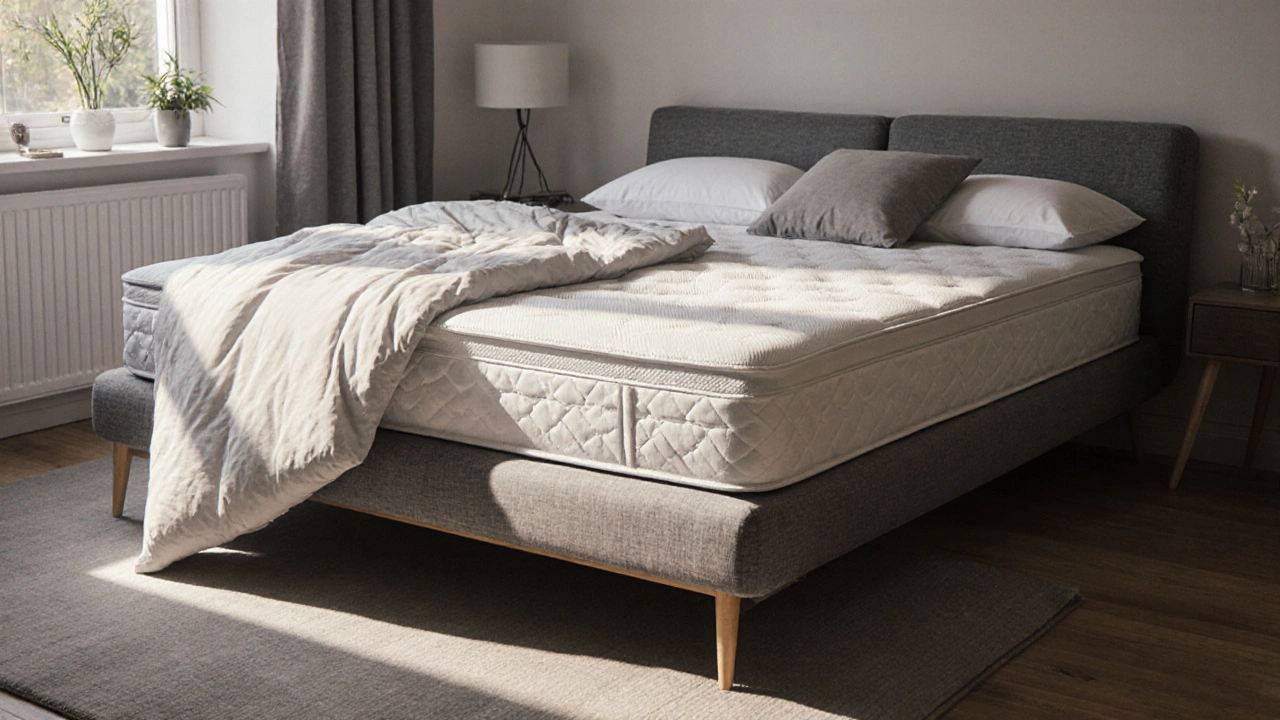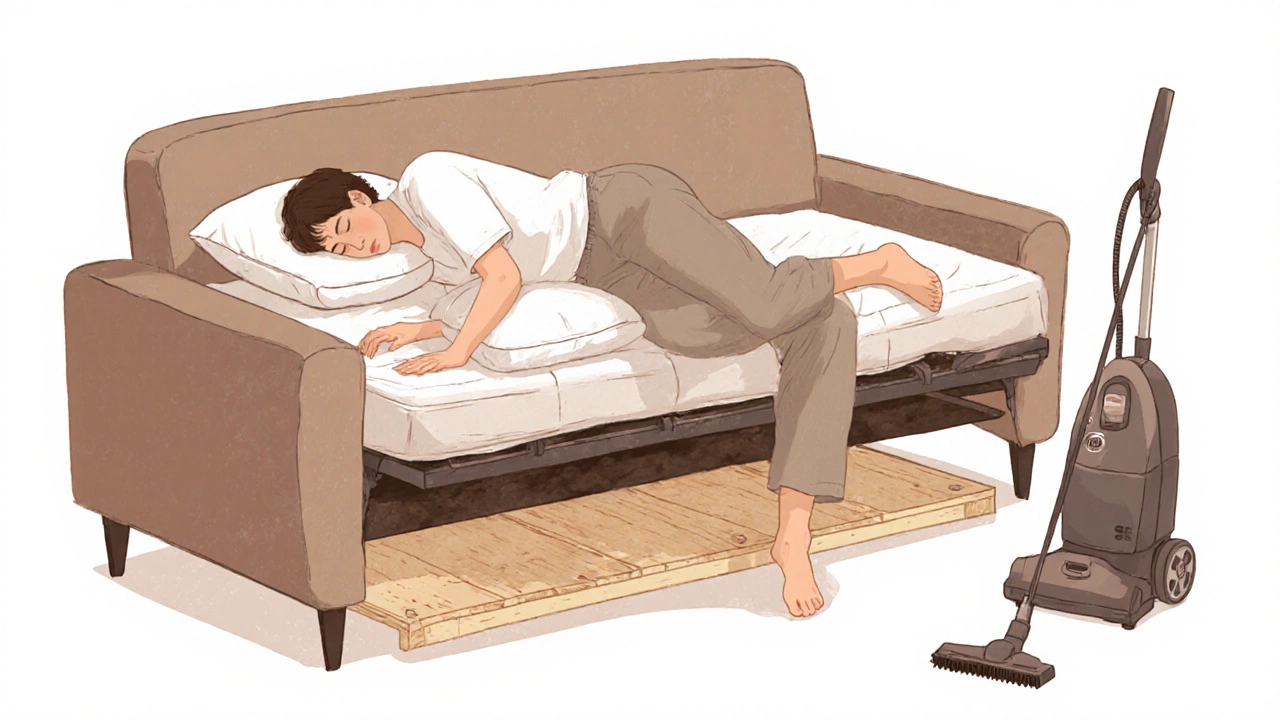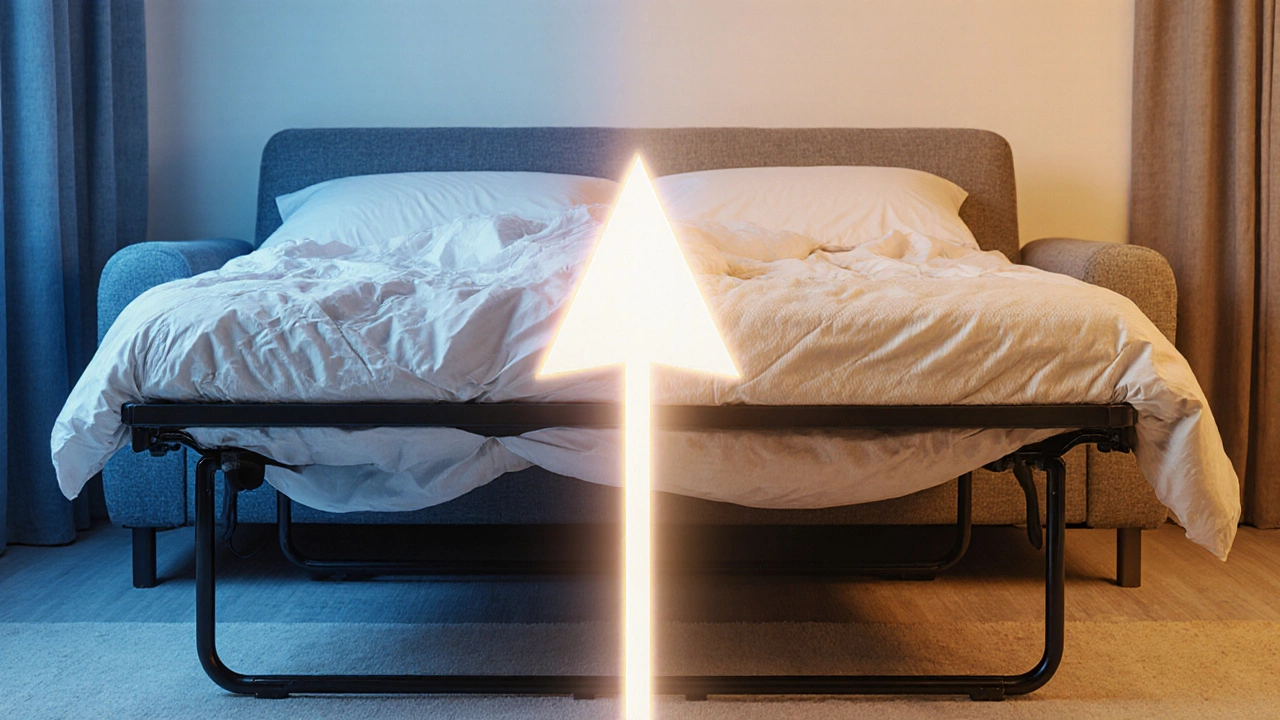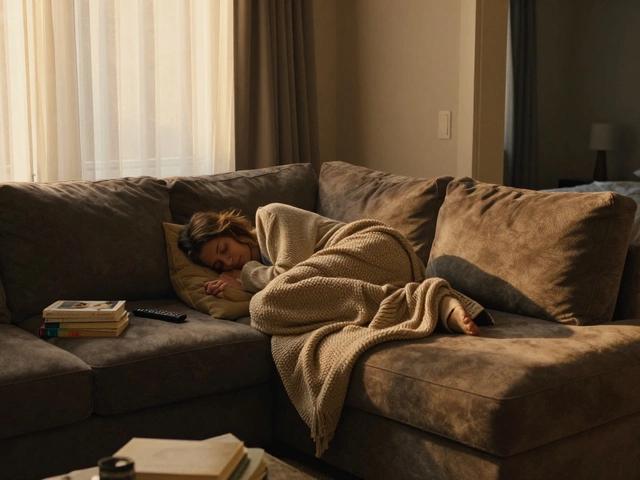 27
Oct,2025
27
Oct,2025
Sofa Bed Dimensions Checker
Check Your Sofa Bed Fit
Ensure your sofa bed frame can accommodate a 6-inch mattress safely. Most standard sofa beds are 54" x 72".
Most sofa beds are built for space-saving, not sleep. You fold it out, lay down, and instantly wish you’d just stayed on the couch. But it doesn’t have to be like that. A sofa bed can be just as comfortable as a real bed-if you know how to fix the common problems most people ignore.
Start with the mattress
The biggest reason sofa beds feel awful is the mattress. Factory-installed ones are usually thin, stiff, and designed to fold, not to support your spine. Most are under 4 inches thick and made of low-density foam that collapses after a few months.
Replace it. A 6-inch high-density memory foam or hybrid mattress is the sweet spot. It’s thick enough to cushion pressure points, firm enough to keep your spine aligned, and still folds without cracking. Brands like Zinus, Linenspa, and even IKEA’s TRÅDFRI series make sofa bed-specific mattresses that fit standard sizes (usually 54x72 inches). Look for a density rating of 1.8 lb/ft³ or higher. Anything lower will sag too fast.
Don’t just buy any foam. Avoid cheap polyfoam that turns to mush after six months. Read reviews that mention long-term use-not just "felt great the first night." Real users report which ones still feel good after a year of weekly use.
Add a topper for extra softness
Even a good mattress can feel too firm for some people. That’s where a 2-inch topper comes in. A memory foam or latex topper adds a layer of cushion without making the sofa bed too bulky to fold.
Latex is more breathable and bounces back faster, which helps if you sleep hot. Memory foam hugs your body better if you have back pain. Avoid down or feather toppers-they flatten out and shift around, making the surface uneven. A quilted cotton cover helps keep the topper in place and adds a soft touch.
Pro tip: Choose a topper with a zip-off, machine-washable cover. Sweat, spills, and pet hair build up fast on sofa beds. Cleaning it monthly keeps it fresh and hygienic.
Layer the bedding right
Bedding isn’t just about looks-it’s part of the comfort system. Skip the thin cotton sheets. Go for 300-thread-count cotton or bamboo blends. They’re soft, breathable, and hold up to daily folding.
Use a fitted sheet with deep pockets (at least 15 inches). Standard sheets won’t stretch over a thick mattress and topper. You’ll end up with a sheet that keeps slipping off, leaving you with exposed foam in the middle of the night.
Add a lightweight duvet or quilt instead of a heavy comforter. Heavy bedding makes it harder to fold the sofa back up in the morning. A down-alternative duvet gives warmth without bulk. Tuck it in loosely so it doesn’t bunch up when you sit on the sofa during the day.

Support the frame
A wobbly or creaky frame ruins even the best mattress. Sofa beds with metal slats or thin wooden frames flex too much, creating pressure points under your hips and shoulders.
Place a 3/4-inch plywood sheet under the mattress. Cut it to fit the bed frame exactly. It spreads weight evenly, stops sagging, and reduces creaking. You can buy pre-cut plywood at hardware stores or have it cut for you. Sand the edges smooth so it doesn’t tear your sheets.
If your sofa bed has a center support bar, make sure it’s touching the floor when the bed is open. If it’s floating, prop it up with a small wooden block or a rolled-up towel. A gap here is the #1 cause of lower back pain.
Use pillows strategically
Pillows aren’t just for your head. They fix alignment issues. Place a thin pillow under your knees if you sleep on your back. It takes pressure off your lower back. If you’re a side sleeper, slip a pillow between your legs to keep your hips level.
Don’t pile up too many pillows behind you when you’re sitting up. That pushes your spine into an unnatural curve. Instead, use a single lumbar pillow behind your lower back when you’re watching TV. It helps maintain posture and prevents stiffness.
Keep it clean and aired out
Sofa beds get used for sitting, sleeping, and sometimes even as a guest room for weeks at a time. Dust, skin cells, and oils build up in the fabric and mattress.
Vacuum the mattress and frame every two weeks with a brush attachment. Spot-clean stains right away with a mix of mild soap and water. Let it air out for an hour after making the bed-open a window or use a fan. Moisture trapped in the mattress causes odors and mildew.
Rotate the mattress every month, even if it’s not reversible. That evens out wear and prevents permanent indentations.

Test it like a real bed
Don’t just assume it’s comfortable because you’ve slept on it once. Try this: sleep on it for three nights in a row. Use the same setup you plan to keep long-term. If you wake up with back pain, numb arms, or you’re tossing and turning, something’s wrong.
Pay attention to how easy it is to fold and unfold. If it takes two people or you have to yank it open, the mechanism is poorly designed. A good sofa bed should open with one hand and lock securely when flat.
After three nights, ask yourself: Would I choose this over my real bed? If the answer is yes, you’ve nailed it. If not, go back and tweak one thing at a time-new mattress, better topper, firmer frame support.
What to avoid
Don’t use a full-size mattress on a twin-sized sofa bed. It won’t fit, and you’ll damage the frame.
Avoid memory foam that’s too soft (under 3 lb/ft³). It sinks too much and makes you feel stuck.
Never skip the plywood support. It’s cheap, easy, and makes the biggest difference.
Don’t use heavy quilts or down comforters. They make folding impossible and trap heat.
And never ignore the smell. If your sofa bed smells musty after a week, the mattress is holding moisture. Replace it before mold sets in.
Final checklist for maximum comfort
- ✅ 6-inch high-density foam mattress (1.8 lb/ft³ or higher)
- ✅ 2-inch latex or memory foam topper
- ✅ Deep-pocket fitted sheet (15+ inches)
- ✅ 3/4-inch plywood under the mattress
- ✅ Lumbar pillow for sitting, knee pillow for sleeping
- ✅ Lightweight duvet (down-alternative)
- ✅ Vacuum mattress every two weeks
- ✅ Rotate mattress monthly
It’s not magic. It’s just physics-proper support, even weight distribution, and breathable materials. Once you fix those, your sofa bed stops being a compromise. It becomes your favorite place to sleep-even better than the guest room.
Can I use a regular mattress on a sofa bed?
No. Regular mattresses are too thick and rigid to fold properly. They’ll damage the sofa bed frame and won’t fit inside the cabinet when closed. Only use mattresses designed for sofa beds-usually under 6 inches thick and flexible enough to bend without cracking.
How often should I replace my sofa bed mattress?
Every 3 to 5 years, depending on use. If you use it daily as a bed, replace it after 3 years. Signs it’s time: sagging in the middle, lumps, difficulty folding, or waking up with back pain. High-density foam lasts longer than cheap polyfoam, so invest in quality from the start.
Why does my sofa bed creak when I move?
Creaking usually comes from metal parts rubbing together or a weak frame. Lubricate the hinges and joints with silicone spray. If that doesn’t help, add a plywood support under the mattress. A lack of center support is the most common cause. If the frame is old or bent, it might be time to replace the whole unit.
Is a memory foam topper better than a feather one?
Yes, for sofa beds. Memory foam and latex toppers hold their shape, provide consistent support, and don’t shift around. Feather toppers flatten quickly, clump up, and make the surface uneven. They also trap heat and are harder to clean. Memory foam is the smarter, longer-lasting choice.
Can I use a sofa bed every night?
Yes, if it’s set up right. Many people in small apartments use sofa beds as their primary bed. The key is using a supportive mattress, adding a topper, and reinforcing the frame with plywood. Just remember to rotate the mattress monthly and keep it clean. With proper care, it can last as long as a regular bed.




